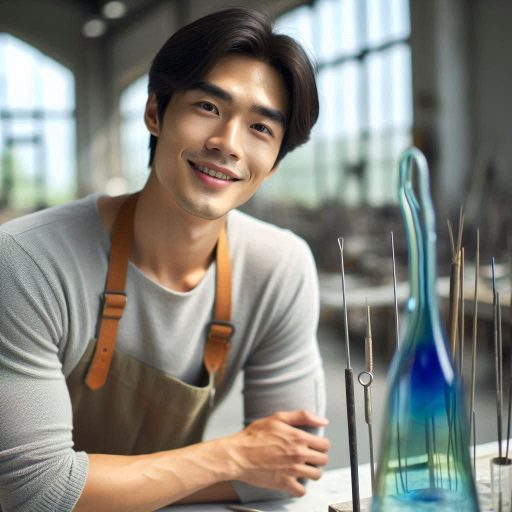Introduction
Glass artistry is a fascinating and intricate form of art that requires skill and precision.
Professional glass artists are skilled individuals who create stunning pieces using various glass techniques.
Interviewing a professional glass artist provides valuable insights into their creative process and techniques for inspiration.
During the interview, we will delve into the artist’s background, inspiration, favorite techniques, and advice for aspiring glass artists.
Background of the professional glass artist
The professional glass artist, Sarah Miller, grew up surrounded by the beauty of stained glass art in her family’s studio.
From a young age, she was fascinated by the way light played on the vibrant colors and intricate designs of glass pieces.
Her passion for glass artistry only grew stronger over the years, leading her to pursue a career in this unique and creative field.
Education and training in glass artistry
Sarah enrolled in a prestigious art school where she studied various techniques in glass artistry, including stained glass, glass blowing, and glass fusing.
She also completed an apprenticeship under a master glass artist, honing her skills and perfecting her craft.
Through years of dedicated practice and continuous learning, Sarah developed her own style and unique approach to glass art.
Career journey and notable achievements in the field
After completing her formal education, Sarah opened her own glass studio where she creates custom pieces for clients all over the world.
Her work has been featured in prestigious galleries and museums, garnering praise for its creativity and craftsmanship.
Sarah has won several awards for her innovative designs and contribution to the field of glass artistry.
She continues to push the boundaries of traditional glass art, experimenting with new techniques and materials to create truly unique pieces.
Overall, Sarah Miller has become a respected figure in the world of glass art, known for her passion, talent, and dedication to her craft.
Read: Sustainable Practices in Glass Art
Artistic processes and techniques used by the glass artist
Glass artist Maria Smith takes pride in her unique artistic process and innovative techniques.
She combines traditional glassblowing methods with modern technology to create stunning pieces.
List of Techniques
- Murano Glassblowing
- Kiln Fusing
- Flameworking
- Glass Etching
- Sculpting and Casting
Every piece created by Maria goes through a meticulous process.
From designing and shaping the glass to adding colors and textures, each step is carefully executed to bring her vision to life.
Transform Your Career Today
Unlock a personalized career strategy that drives real results. Get tailored advice and a roadmap designed just for you.
Start NowThe Artist’s Studio and Workspace
Maria’s studio is a spacious and well-lit area filled with various tools and equipment for glass artistry.
The space is divided into different sections for different stages of the creative process.
Studio Features
- Large glassblowing furnace
- Worktables for shaping and cutting glass
- Colorful glass rods and sheets
- Kiln for fusing and slumping glass
- Display area for finished pieces
The studio also has a cozy corner with a comfortable chair where Maria spends hours sketching and planning her next project.
The walls are adorned with sketches, inspirational quotes, and finished works for motivation.
Sources of Inspiration for Their Work
Maria finds inspiration for her glass art in various aspects of life.
Nature, particularly the intricate patterns found in plants and flowers, plays a significant role in shaping her designs.
Sources of Inspiration
- Nature and Wildlife
- Travel and Cultural Experiences
- Art History and Architecture
- Personal Emotions and Experiences
- Collaborations with Other Artists
Maria’s travels around the world have exposed her to different art forms and cultural traditions, which she incorporates into her work.
She also draws inspiration from personal experiences and emotions, using glass as a medium to express her feelings.
In fact, Maria Smith’s artistry is a reflection of her passion, dedication, and artistic vision.
Her use of innovative techniques, well-equipped studio, and diverse sources of inspiration contribute to the uniqueness of her glass creations.
Each piece tells a story, capturing the essence of Maria’s creative spirit and making her a truly exceptional glass artist in the industry.
Read: Exploring Different Styles of Calligraphy Art
Challenges faced by the glass artist in their career
Common challenges faced by glass artist in their career
- Lack of recognition and appreciation in the art world.
- High competition from other artists and different mediums.
- Expensive materials and equipment required for glass art.
- Technical difficulties in working with glass, like temperature control.
- Finding a balance between creativity and commercial viability.
Strategies for overcoming obstacles in the field
- Building a strong personal brand and online presence.
- Networking with other artists and galleries to showcase work.
- Continuous learning and improvement of glass art techniques.
- Seeking mentorship from experienced glass artists in the industry.
- Creating a diverse portfolio to appeal to different audiences.
Advice for aspiring glass artists looking to enter the profession
- Start with basic glass techniques and experiment with different styles.
- Attend workshops, classes, and art fairs to learn and showcase work.
- Develop a unique artistic voice and stay true to your vision.
- Be open to criticism and feedback to grow as an artist.
- Stay passionate and dedicated to your craft, success will follow.
Read: Famous Calligraphers and Their Iconic Works

Impact of technology and innovation on glass artistry
Technology and innovation have revolutionized the field of glass artistry, offering artists a myriad of new tools and techniques to explore and express their creativity.
From advanced glassblowing equipment to digital design software, artists now have access to a wide range of resources that have transformed the way they work.
One of the most significant impacts of technology on glass artistry is the ability to create more intricate and complex pieces.
With the help of computer-aided design (CAD) software, artists can now visualize their ideas in 3D and experiment with different shapes and structures before even touching the glass.
This has opened up a whole new world of possibilities for artists, enabling them to push the boundaries of traditional glass art.
Advancements in glassmaking techniques drive artistic innovation.
Showcase Your Business Today
Reach thousands of readers actively exploring professional services. Publish your business profile and grow your audience now.
Publish NowNew glass types emerge, expanding creative possibilities. Innovative tools enhance precision in artists’ work.
Artists gain better control over their techniques and designs.
Whether it’s creating delicate details or working on a larger scale, artists now have the tools they need to bring their vision to life with unparalleled accuracy.
Overall, technology has had a profound impact on the world of glass artistry, empowering artists to experiment with new techniques and push the boundaries of what is possible with this versatile medium.
Traditional versus modern approaches to glass art
When it comes to glass artistry, there is often a debate between traditional and modern approaches.
Traditional methods of glassmaking, such as glassblowing and stained glass, have been practiced for centuries and continue to hold a special place in the hearts of many artists.
On the other hand, modern approaches to glass artistry involve the use of cutting-edge technology and innovative techniques to create unique and innovative pieces.
While some artists prefer to stick to traditional methods, others embrace the possibilities offered by modern technology to create truly groundbreaking works of art.
One of the key differences between traditional and modern approaches to glass art is the emphasis on craftsmanship versus innovation.
Traditional artists hone their skills and master techniques.
Modern artists experiment with new materials and processes.
They push the boundaries of traditional glass art.
Ultimately, both traditional and modern approaches have their own merits, and the choice between the two often comes down to personal preference and artistic vision.
Whether an artist chooses to stick to tradition or embrace innovation, there is no denying the beauty and versatility of glass as a medium for artistic expression.
Future trends in the field of glass artistry
As we look towards the future of glass artistry, several trends are emerging that are set to shape the industry in the years to come.
One of the most prominent trends is the fusion of traditional and modern techniques, as artists seek to combine the best of both worlds to create truly innovative pieces.
Additionally, sustainability is becoming an increasingly important factor in the world of glass artistry, with artists and consumers alike placing a greater emphasis on eco-friendly practices and materials.
From recycling glass to using sustainable energy sources in the production process, sustainability is set to play a key role in shaping the future of glass artistry.
Another trend to watch out for in the field of glass artistry is the growing popularity of collaborative projects and interdisciplinary collaborations.
Artists increasingly collaborate with architects and designers.
They also work with scientists on unique projects.
This teamwork pushes the boundaries of traditional glass art.
These multidisciplinary works redefine artistic expression.
The future of glass artistry shines brightly. Artists embrace new technologies and sustainable practices.
They adopt collaborative approaches for groundbreaking creations.
These works captivate audiences worldwide.
Read: How to Build a Glass Art Portfolio
Collaboration and community within the glass art world
As a professional glass artist, one of the most rewarding aspects of my work is the opportunity to collaborate with other artists in the glass art world.
Collaboration allows artists to share ideas, techniques, and creativity, leading to the creation of unique and innovative works of art.
Through collaboration, artists can push the boundaries of their own artistic practice and learn new skills from one another.
Collaboration fosters a sense of community within the glass art world, as artists come together to support and inspire one another.
Whether working on a joint project or simply sharing a studio space, collaboration allows artists to connect on a deeper level and build relationships that can last a lifetime.
Participating in exhibitions, events, and workshops
Participating in exhibitions, events, and workshops is an essential aspect of being a professional glass artist.
These opportunities allow artists to showcase their work to a wider audience, gain recognition in the art world, and connect with collectors and buyers.
Exhibitions provide a platform for artists to display their work in a gallery or museum setting, allowing them to reach a larger audience and receive feedback from art critics and curators.
Art fairs, festivals, and open studios provide excellent networking.
Artists connect with other professionals in the field.
They engage with the public effectively. These events also offer opportunities to sell their work.
Workshops offer artists the chance to learn new techniques, experiment with different materials, and expand their creative practice.
They also provide a space for artists to connect with other artists and share their passion for glass art.
Showcase Your Business Today
Reach thousands of readers actively exploring professional services. Publish your business profile and grow your audience now.
Publish NowInvolvement in teaching and mentorship opportunities
Teaching and mentorship opportunities are another important aspect of being a professional glass artist.
By sharing their knowledge and expertise with others, artists can inspire the next generation of glass artists and contribute to the growth and development of the glass art community.
Teaching allows artists to pass on their skills and techniques to students of all ages and skill levels.
By teaching workshops, classes, and private lessons, artists can help others learn the art of glassmaking and develop their own artistic style.
Mentorship involves fostering a one-on-one relationship with a less experienced artist, providing guidance, support, and feedback to help them grow and improve their work.
Mentorship can be a rewarding experience for both the mentor and the mentee, as they learn from each other and form a lasting bond.
In a nutshell, collaboration, community engagement, participation in exhibitions, events, and workshops, as well as involvement in teaching and mentorship opportunities are all essential aspects of being a professional glass artist.
By actively engaging with the glass art world in these ways, artists can enrich their practice, expand their networks, and make meaningful contributions to the artistic community.
You Might Also Like: Successful Fashion Designers to Follow
Discover More: Key Differences Between Product and Industrial Design
Conclusion
Glass artistry is a fascinating craft that requires dedication and skill.
The interview provided valuable insights into the world of professional glass art.
Recap of key insights and highlights from the interview
- The artist shared the inspiration behind their work.
- They discussed the techniques and tools used in glass art.
- The challenges and rewards of working in the field were highlighted.
- The importance of creativity and innovation in glass artistry was emphasized.
Final thoughts on the significance of professional glass artistry and the value of interviewing experts in the field
Professional glass artistry is a unique form of expression that requires a deep understanding of the medium.
Interviewing experts in the field provides valuable knowledge and insights that can inspire and educate others.
Learning from these artists enhances our appreciation for glass art.
We see the dedication required to create stunning pieces.
Their skill inspires us to explore this art form.
Interviewing professionals in the field preserves glass artistry.
It promotes this beautiful craft for future generations.
This ensures the craft continues to thrive.
[E-Books for Sale]
The Big Book of 500 High-Paying Jobs in America: Unlock Your Earning Potential
$19.99 • 500 High-Paying Jobs • 330 pages
Explore 500 high-paying jobs in America and learn how to boost your career, earn more, and achieve success!
See All 500 High-Paying Jobs of this E-Book
1001 Professions Without a Degree: High-Paying American Jobs You Can Start Now
$19.99 • 1001 Professions Without a Degree • 174 pages
Discover 1001 high-paying jobs without a degree! Unlock career tips, skills, and success strategies for just $19.99!




